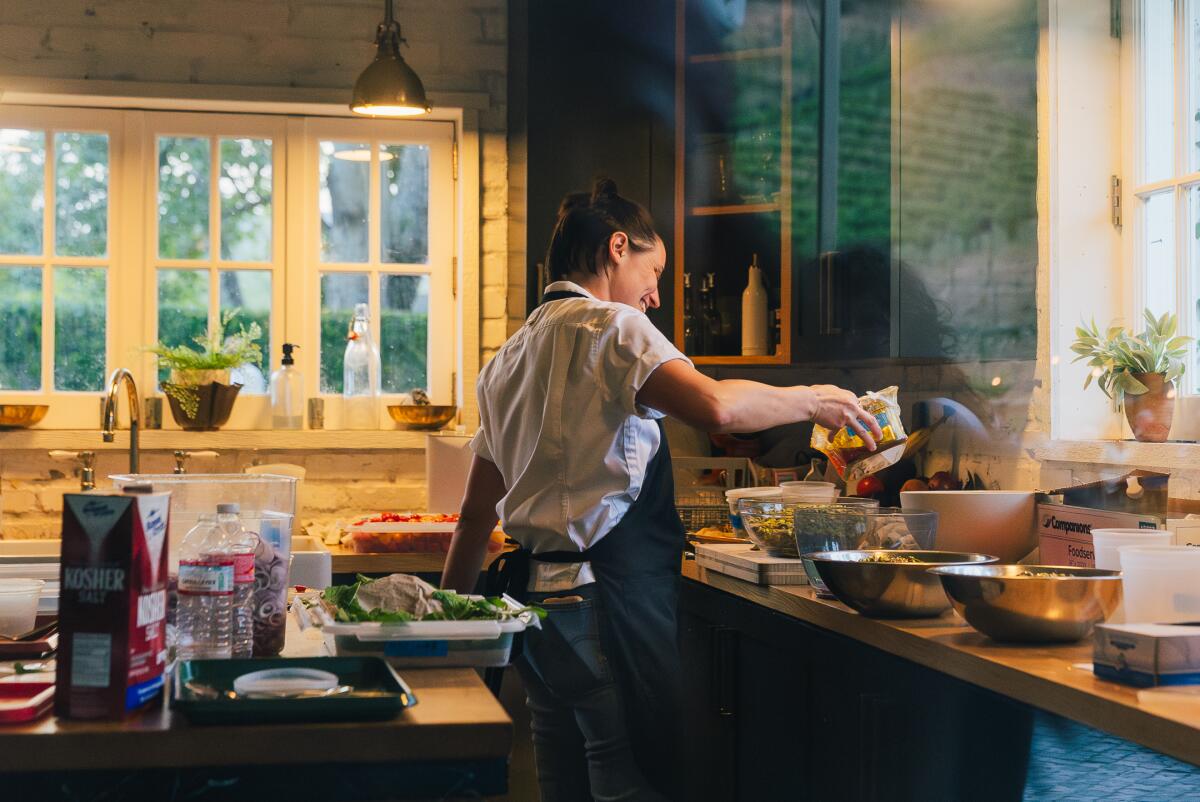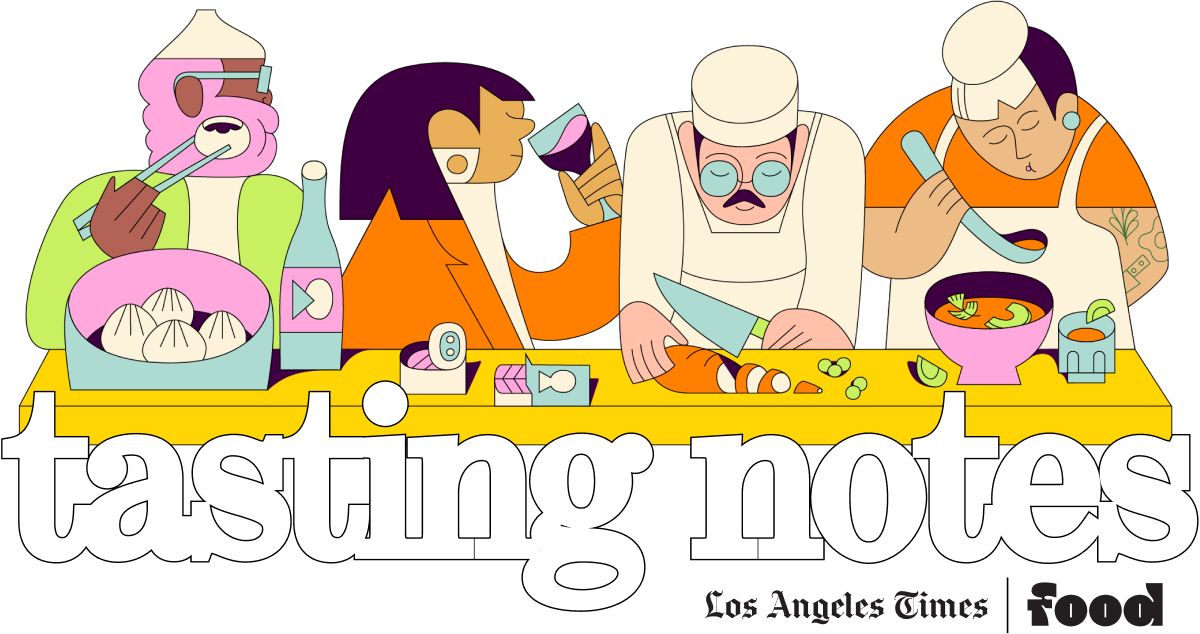Distilling seven Australian seasons in a bottle ... with ants

- Share via
Ants in gin, Australia’s rule-breaking chefs, Adam Leonti’s date-night pasta, curbing L.A.’s cream-top enthusiasm, Chin Chin’s endangered Chinese chicken salad and more. I’m Laurie Ochoa, general manager of L.A. Times Food, with this week’s Tasting Notes.
Land of rule breakers

For Daniel Motlop and his fellow Larrakia people in the Darwin region of northern Australia, there are not four seasons but seven. Some seem intuitive for outsiders to grasp — the rainy season (balnba), monsoon season (dalay), heavy dew time (dinidjanggama) and big wind season (gurrulwa). Others are named not only for weather changes but animal and plant patterns as well as harvest traditions, such as barramundi and bush fruit time (damibila), build-up time (dalirrgang) and the speargrass, magpie goose egg and ‘knock ‘em down’ season (mayilema).
These seasonal variations are different from ones observed by other indigenous societies in the country.
“In Australia,” said Motlop, who built on his fame as an Australian rules football star to become a native foods entrepreneur, “we’ve got over 500 different aboriginal groups.”
For instance, the Woiwurrung, of the Yarra River Valley in the country’s southern reaches, observe eel (iuk) season and kangaroo-apple (garrawang) season.
A sense of place, ancestry and the rhythms of nature are important for Motlop. Which is why he named his distillery company Seven Seasons — to honor the heritage, he says, “of my grandmother’s country up in Darwin.”

Last week, Motlop was in Southern California pouring samples of some of his distilled spirits at the Great Australian Bite, an L.A. Times food event held at chef Curtis Stone‘s Four Stones Farm in Agoura Hills.
“Different signs in nature tell us when a season’s starting,” Motlop said during the welcome drink hour. “A lot of these native ingredients represents a certain season.”
One of his most popular distilled spirits is a kind of vodka made, Motlop said, with “yams harvested by aboriginal people up at the top end of Australia” during the rainy season. In the build-up season, just before the rains hit, he said, “you can’t really find that yam.” But with the rains’ arrival, little bell flowers pop up from the yams in the ground, a sign that the tubers, which come in multiple varieties, can be harvested. One of the yams Motlop’s team uses in Seven Seasons spirits is “quite creamy,” he said, “and another one is a bit like horseradish.” These are blended together, evoking, Motlop said, “the flavor of the earth.”
His most unusual and sought-after spirit might be green ant gin, made with boobialla, which is a native flowering juniper; strawberry gum, a kind of eucalyptus with a bell-shaped fruit; lemon myrtle; pepper berry, and, floating in the liquid if you give the bottle a shake like a snow globe, green bush ants, which Motlop says adds a pop of citrus flavor. (He points out that only the worker ants are used for the gin and the harvest never happens during the ants’ breeding season.)
Seven Seasons’ spirits aren’t easy to find at this moment in Southern California, but gin from another Australian small craft distillery pouring at last week’s event, Four Pillars, based in the Yarra Valley, is sold in many L.A.-area stores, including Total Wine and Woodland Hills Wine.
“Australia went from about eight distilleries to about 600 distilleries in a period of about 20 years,” wine and spirits writer Mike Bennie said at the event. “There’s been a massive interest in the utilization of native ingredients in Australia ... and tasting Australia through the native things that don’t grow anywhere else.”
Native ingredients are just one aspect of Australian culture that make its cuisine distinct from other places and hard to define. In some respects, it’s like California, both for its climate, openness to new flavors and the multiplicity of international influences that appear on the plate. Last week, restaurant critic Bill Addison wrote about eating at Jung Eun Chae and Yoora Yoon‘s Korean restaurant Chae outside of Melbourne, where the food, he said, “expressed another side of the culinary Korean diaspora unlike anything I’ve experienced.”
Clare Falzon, who traveled from her Barossa Valley restaurant Staġuni to join Stone as co-chef for the Great Australian Bite, brings her family’s Maltese heritage into her cooking.

“I’m utilizing memories from my childhood experiences from when I was overseas, as well as produce from Australia,” she said after serving guests freshly baked flatbread topped with smoked tomato cream, amaranth, sumac and basil. “Malta has Italy to the north and North Africa to the south so that’s quite a lot of cultures smashed together.”
“You know, your background is Maltese, mine are convicts,” Stone said to Falzon, taking a break from the grill where he was serving spiced lamb ribs to the crowd. “The truth is, we’re rule breakers in Australia. We’re a little anti-authoritarian. And I think you see that in the cuisine. You see lots of different multicultural influences and you also see a real spirit.”



Also ...

Date-night pasta: Watch Alba chef Adam Leonti make his lightly smoky spaghetti with lemon, which may be the perfect dish to make for a date. Find the recipe here.

- Lopping off the cream top: Two of Southern California’s most distinctive coffee spots — Maru Coffee in the Arts District and Mandarin Coffee Stand in Pasadena — have stopped offering cream-top add-ons for their drinks. “It just went a little out of control,” Mandarin owner Sherry Gao told The Times’ Lauren Ng, who reports on the roots of the trend and why two of its most popular purveyors have had enough.

- Endangered icon: The Chinese chicken salad that Chin Chin made famous in Los Angeles isn’t completely disappearing — it’s still sold in Studio City, Brentwood and Las Vegas. But the mini chain’s original Sunset Plaza location, which helped glamorize the tart-sweet and crunchy salad — Britney Spears and the Kardashians are among its many celebrity fans — is shutting down next month. The Times’ Stephanie Breijo reports on the reasons behind the closure.
- And in Breijo’s restaurant openings report, details about the return of Korea’s barbecue chain Baekjeong to L.A.’s Koreatown after the restaurant founded by TV personality and former wrestler Kang Ho Dong closed for a year and a half. Plus, the expansion of chef Avner Levi’s Cento Pasta Bar into Cento Raw Bar next door; the Bar Benjamin spin-off of the Benjamin; the new Saijo Hand Roll Bar in Culver City from the founder of the ramen chain Jinya, and a new Venice location of Marathon Burger, “the culinary offshoot of the late rapper Nipsey Hussle’s lifestyle brand from Hussle’s brother and business partner Samiel “Blacc Sam” Asghedom.
- Plus, in the most recent installment of L.A. Timeless, which resurfaces classic stories from the paper’s archives, Jonathan Gold’s 2016 review of Koreatown’s sullungtang specialist Sun Nong Dan, which is best known for its killer galbi jjim, or short rib stew, topped if you like with blow-torch-melted cheese. “The galbi jjim at Sun Nong Dan is Hendrix shredding a Bob Dylan song or David Choe slapping paint onto a wall, all the sensations of the dish run through a distortion pedal and cranked up to 10.”
Reading around ...
- Agricultural sprawl: “Urban sprawl is a rounding error compared with agricultural sprawl. ... In the U.S., nearly half that land is used to produce beef, which provides just 3 percent of U.S. calories. ... If current trends hold, the world’s farmers will have to clear at least a dozen more Californias’ worth of land to fill nearly 10 billion human bellies by 2050. ... The good news is that remarkable people are working on this eating-the-Earth problem, and their work can be antidotes to climate fatalism.” From an Atlantic magazine excerpt of Michael Grunwald’s forthcoming book “We Are Eating the Earth: The Race to Fix Our Food System and Save Our Climate.”
You’re reading Tasting Notes
Our L.A. Times restaurant experts share insights and off-the-cuff takes on where they’re eating right now.
You may occasionally receive promotional content from the Los Angeles Times.
Eat your way across L.A.
Like what you're reading? Sign up to get it in your inbox every week.
You may occasionally receive promotional content from the Los Angeles Times.

Eat your way across L.A.
Get our weekly Tasting Notes newsletter for reviews, news and more.
You may occasionally receive promotional content from the Los Angeles Times.




